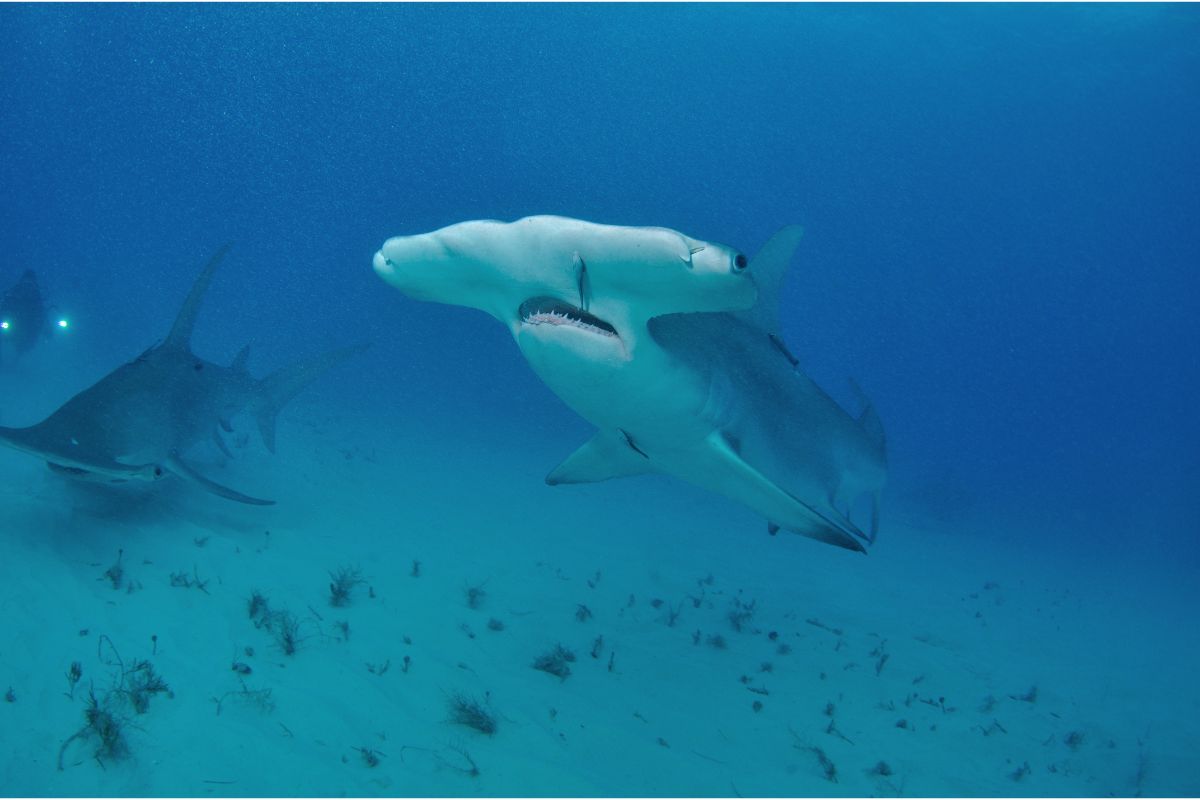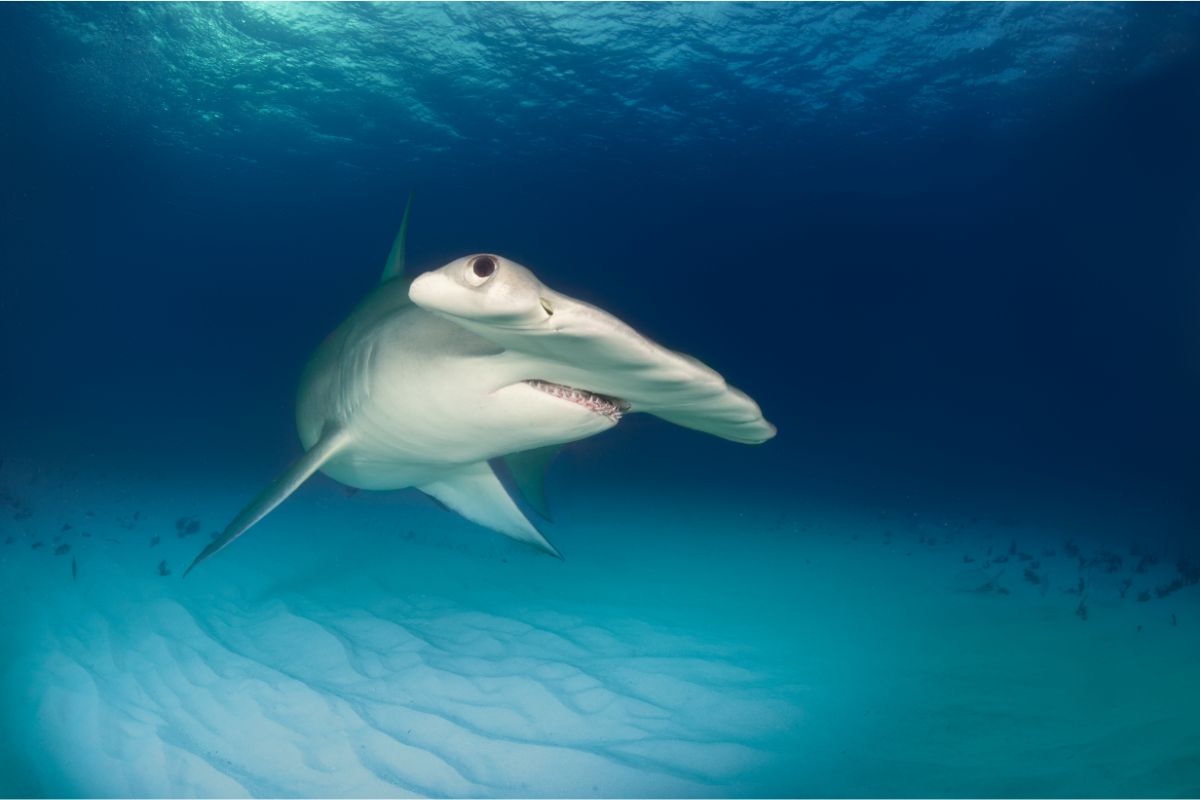The hammerhead shark boasts one of the most remarkable appearances in the entire animal kingdom.
Featuring a snout that culminates in a long, flat line rather than a point, and eyes at the very periphery of this hammerhead-like physique, this shark is as distinct as a creature can be.

Are Hammerhead Sharks Dangerous Animals?
Like a lot of sharks, most species of hammerhead are adept hunters, aquatic killing machines refined to perfection over millions of years of evolution.
They are deadly creatures, alright, not so much to us, but boy do I feel bad for the unassuming sea life they bump into.
Have There Been Many Hammerhead Shark Attacks?
For the most part, hammerheads are quite small and harmless to humans, although they have been known to act aggressively in self-defense, so don’t rub one of these critters the wrong way.
Measuring up to 20 feet long and weighing around 1000 lbs, the only species of hammerhead thought to be a potential threat is the Great Hammerhead, but even these goliaths of the ocean are unlikely to attack a human.
There have been only 17 instances of unprovoked hammerhead attacks, none of which were fatal.
What Is The Diet Of A Hammerhead Shark Like?
Okay, so we’ve established that humans aren’t on the hammerhead menu — Phew!!! But what do these wonderful creatures enjoy scarfing?
Well, much like most of their shark cousins, hammerheads have incredibly sharp, serrated teeth, so they have a pretty wide range of prey to choose from.
Their favorite feasts are usually composed of squids, rays, crustaceans, and even other hammerheads.
Yep, you read that right, folks — hammerheads are often cannibals, but cut them some slack; it can’t be easier getting by in the briny deep.
As for how that hammerhead of theirs comes in handy on the hunt, one example would be when they use it to pin rays to the ocean floor, giving them the green light to chomp away at their poor victim.
During the daytime, they tend to hunt in large shivers (the collective noun for sharks) of up to 100, but when the sun goes down, they go full lone wolf and scour the depths for a solo feed.
Where Do Hammerhead Sharks Call Home?
You’ll find various species of hammerhead sharks in all temperate and tropical oceans, preferring continental shelves and coastlines — shallow areas make hunting easier.
Dimensions Of A Hammerhead
On average, you can expect a full-grown hammerhead to reach roughly 11.5 feet (3.5 meters) in length, but it’s not entirely unheard of for some to reach almost twice that length.
The largest determining factor when it comes to size is species.
There are nine species of hammerhead shark in total, and some are much larger than others.
Are Hammerhead Sharks Classed As Endangered?

The following species of hammerhead shark are classed as either critically endangered or vulnerable by the IUCN:
- Smooth Hammerhead (Vulnerable)
- Great Hammerhead (Critically Endangered)
- Scalloped Hammerhead (Critically Endangered)
As you can imagine, hammerheads don’t have many natural predators, but they are put at risk by human activities such as overfishing.
For example, did you know that in Australia, it’s legal to catch 370 tons of hammerhead annually?
What’s With The Hammerhead?
The shape of their heads seems rather impractical when compared to the torpedo-esque snout of other shark species, but this is actually what makes them such successful hunters.
The structure of their vertebrae is unique amongst sharks and allows them to maneuver nimbly in the water.
Furthermore, the shape of the snout provides bundles of extra lift, making them some of the most buoyant creatures in the sea.
To top things off, both their eyes and nostrils are stationed at opposite poles of their snout, giving them an incredibly receptive, locational sense of smell and 360-degree vision.
What Is The Lifespan Of A Hammerhead Shark?
On average, hammerhead sharks live for 20 to 30 years, but there are exceptions. One Boca Grande female was thought to be between 40 and 50 years old.
Hammerhead Sharks: Appearance
As mentioned earlier, the most notable feature of the hammerhead is, well… the hammerhead. They have a flat head that extends laterally with eyes and nostrils stationed on the periphery of the protrusions.
They tend to be gray with a white belly, but specimens with a brown tinge across the back have been documented.
In typical shark fashion, they have two dorsal fins (one large and one small), pectoral fins, a pelvic fin, and an anal fin. In juveniles, fin tips can be black.
Hammerhead Reproduction
Hammerheads exhibit what is known as viviparous reproduction, which in plain English means that they give birth to live young as opposed to eggs. Fertilization takes place internally via “claspers” (intromittent organs).
Having said that, it was discovered recently that female hammerhead sharks can reproduce asexually, something that has never been seen in any other shark species.
I Heard That Hammerhead Sharks Can Suntan
You heard right! Along with humans, pigs, and a select few other animals, hammerhead sharks will tan if exposed to sunlight for extended periods due to swimming close to the water’s surface.
Final Thoughts
The hammerhead shark is an intriguing animal, astounding in a number of ways, both in its appearance and behavior, so don’t stop here; keep on studying these wonderful creatures.
They’ll continue to amaze you the more you learn about them.
- Is It Possible For A Shark To Swim Backwards? - August 2, 2022
- Are Leopard Sharks Dangerous? - August 2, 2022
- What Are The Differences Between Shark And Dolphin Fins? - August 1, 2022








